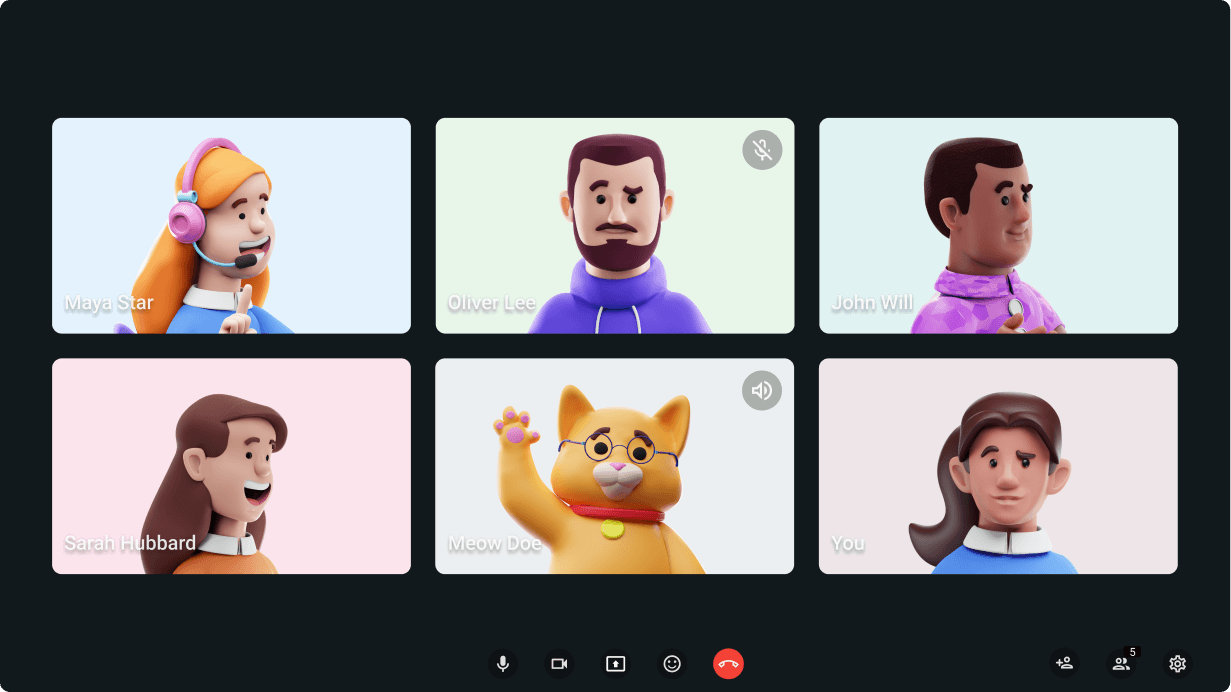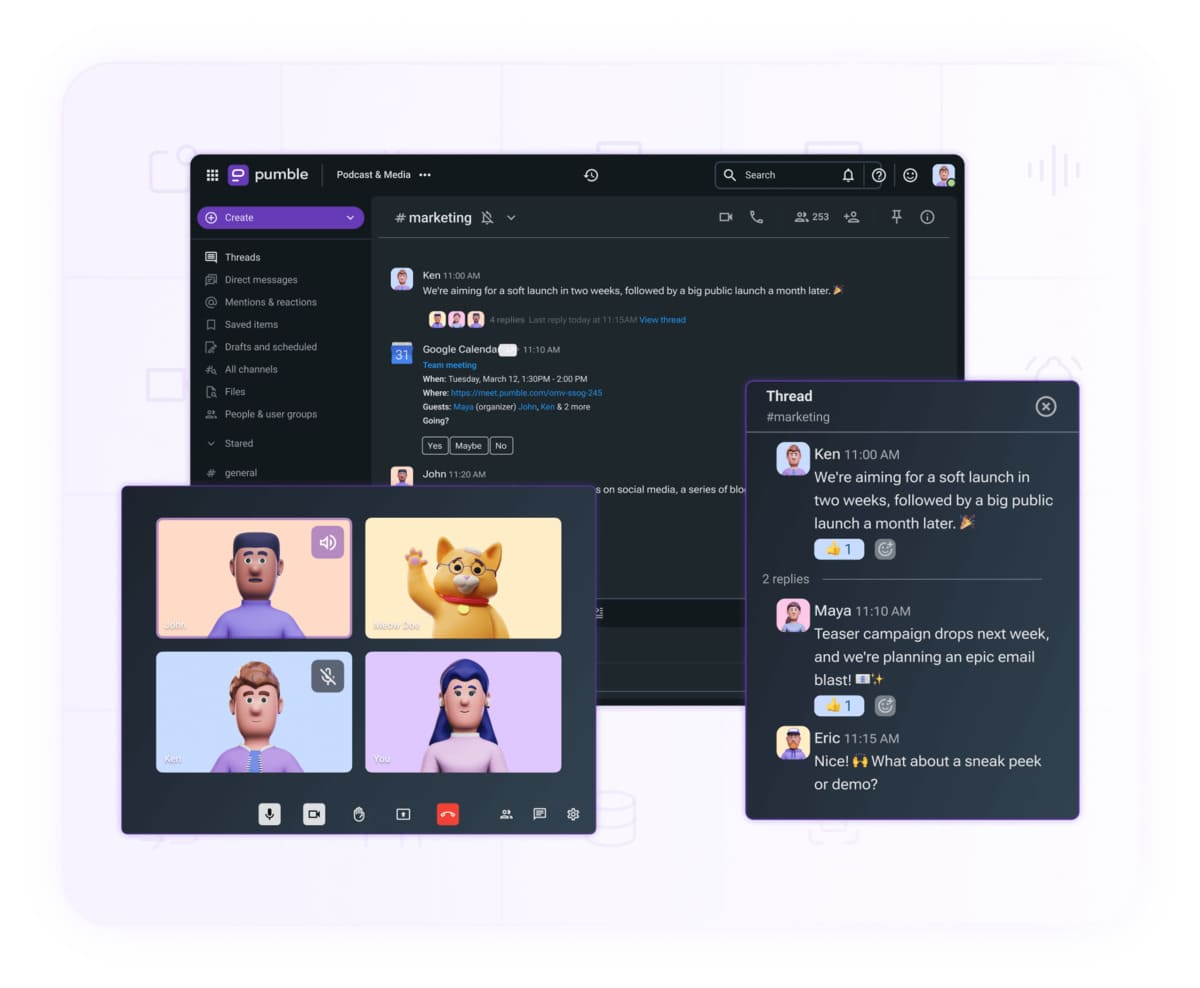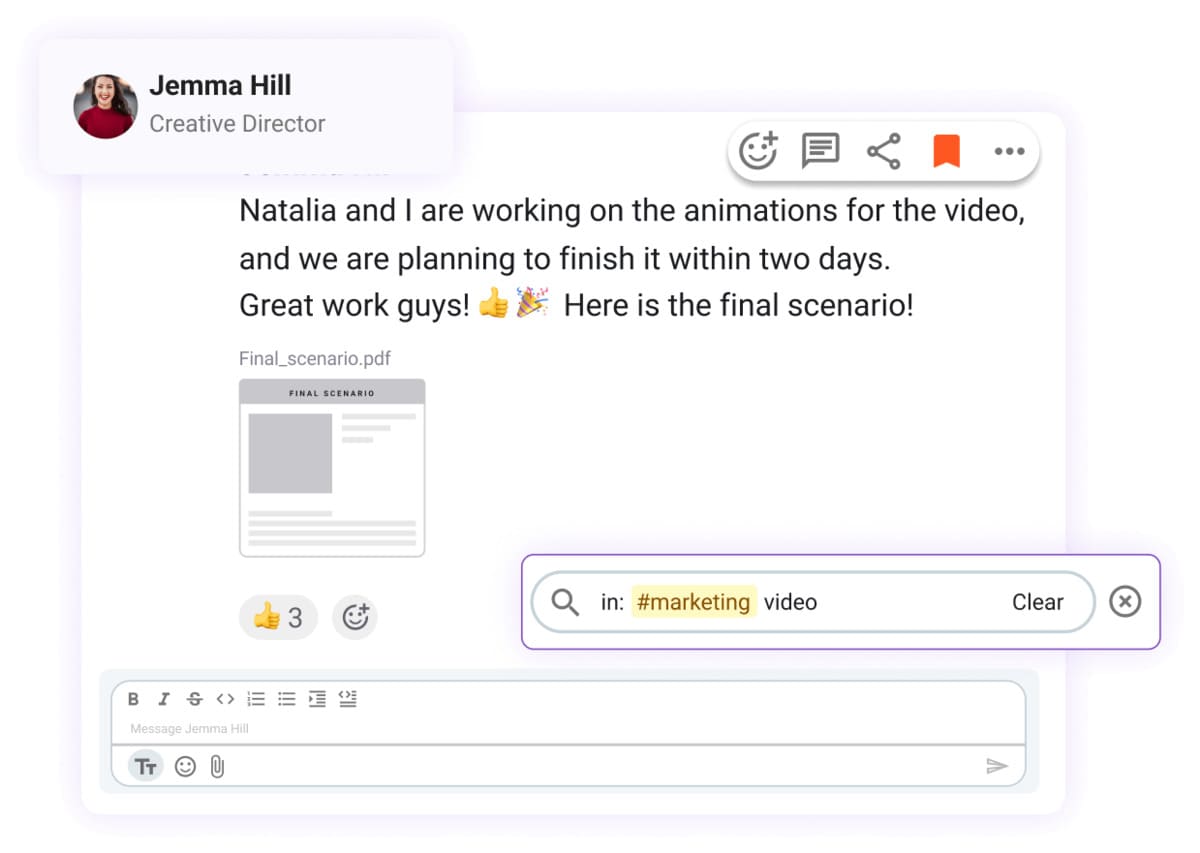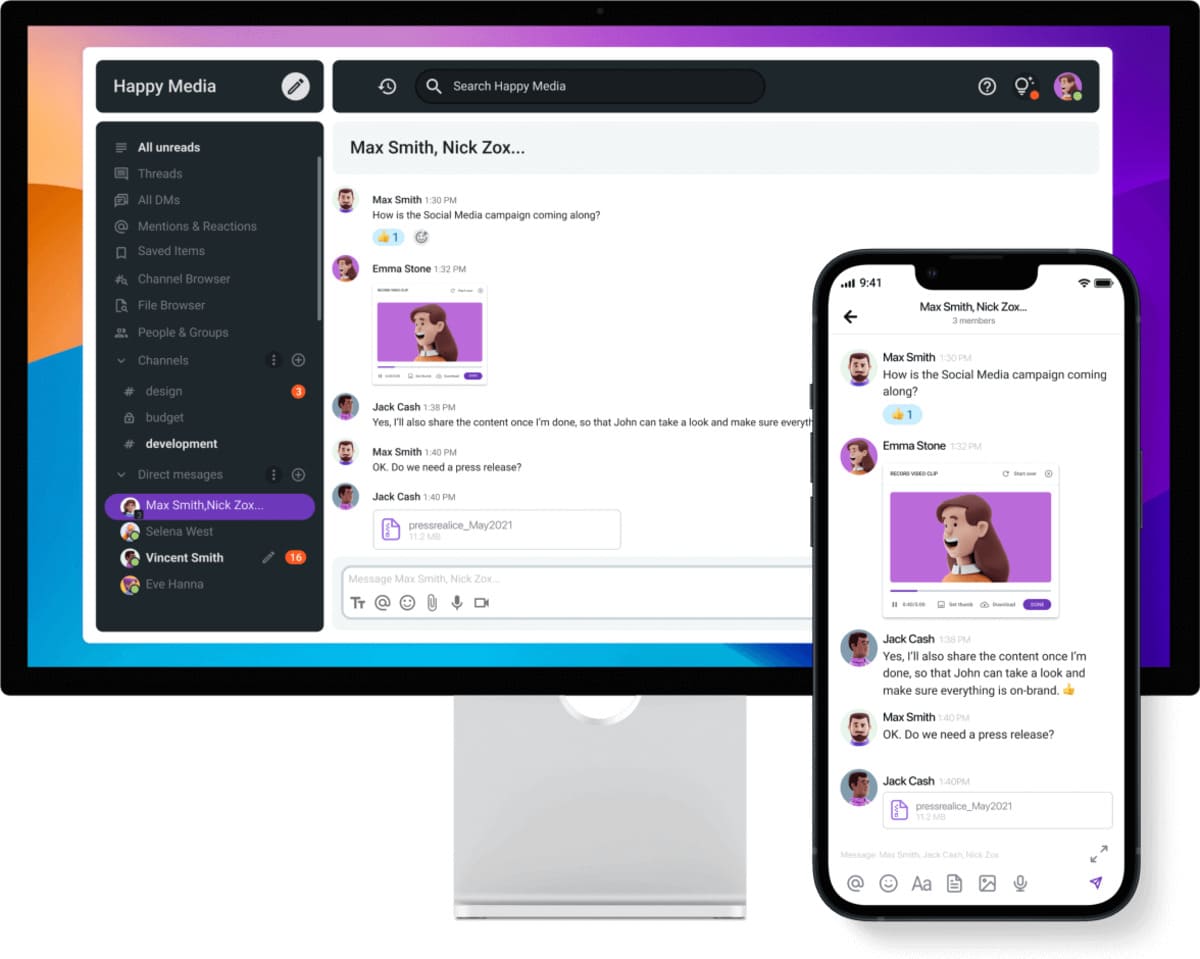Imagine a crisis hits your team, and you look to management for clarifying information.
The response — crickets.
And just like that, a bad situation has become worse.
This is why businesses around the globe have begun investing in effective employee communication — to make sure staff and management have a healthy relationship that can weather any storm.
Even when everything is going well, the back and forth between management and staff ensures unfaltering employee performance and a pleasant work environment.
So, what can you do to implement an employee communication strategy, and why does it matter?
Let’s find out.

Table of Contents
What is employee communication?
Employee communication is the dialogue between team members and leadership. It yields the best results when all parties are transparent, speaking freely about what’s going well and what requires more attention.
Ideally, these exchanges go in both directions.
Managers take the time to:
- Actively listen to their teams,
- Solicit employee feedback, and
- Ask thought-provoking questions.
These efforts then empower employees to speak candidly about their concerns, suggestions, and observations.
This may vaguely remind you of internal communication, which begs the question — is there a difference between employee and internal communication?
In short, there is.
While employee communication refers to the line between employees and their superiors, internal communication describes interactions between staff members at any level ( i.e., conversations between members of the same team or a team lead speaking to an accountant or office manager, etc.).
When executed correctly, both are invaluable communication strategies that can lead to high levels of job satisfaction and more engaged employees.
The importance of employee communication
At an age where it is increasingly easy to recruit global talent, reaching employees in a proactive and timely manner matters more than ever.
According to a teleworking report from the U.S. Bureau of Labor Statistics, 1 in every 5 employees works from home. This means that current work environments have become more diverse. As a result, businesses require more reliable employee communication tactics to nurture and maintain a well-connected workforce.
Should you manage to achieve this goal, here’s what you can expect:
- Boosted morale and engagement: Engaged employees are quick to acquire new skills and use them to achieve company objectives. Keeping everyone well-informed builds trust and, in turn, makes them feel like they have a personal stake in their day-to-day duties. And, when the news they receive from their manager feels closely tied to their roles, employees feel more connected to their responsibilities.
- An inclusive work culture: When effective employee communication is a pillar of company values, it also becomes a staple of organizational culture. As a result, it guarantees fair and respectful conversations with employees regardless of their personal beliefs or background.
- Stronger collaboration: Regular employee communication sets an example, encouraging staff to reach out to colleagues in case of issues or concerns. Not to mention, when managers model respectful communication, we feel at ease when contacting coworkers, which sets the tone for cross-functional collaboration and overall teamwork.
- Higher retention rates: When leadership keeps us in the loop, we feel our contributions are acknowledged and appreciated. Consequently, we’re less likely to leave work environments where we feel valued, and feeling like your work matters has a lot to do with employee communication.
💡 Pumble Pro Tip
Improving morale and engagement at work is important, yet it remains a pain point for many organizations. To read up on these topics and discover actionable advice, head to these resources:
Different modes of employee communication
The benefits of employee communication only appear when you select the method that fully supports your needs.
Some of the most prominent employee communication strategies include:
- Email: For a long time, email was the primary way of communicating with employees. Although emailing encourages asynchronous communication, it also brings a host of issues, including full inboxes, missing information, project delays, and more. Consequently, many organizations today opt for email alternatives.
- Intranets: Think of intranet as a privately owned network used exclusively for workplace purposes. While communicating with employees via an intranet is more secure than using a public network, it’s not always an optimal solution. Namely, hybrid and remote workers may struggle to access the network, which rarely supports mobile access.
- Instant messaging apps: There are many advantages to using instant messaging for business purposes — it’s quick, user-friendly, and typically affordable. However, the downside is that most popular IM apps were designed for personal use, and many companies have faced severe repercussions, such as information leaks and compromised security.
- Business communication platforms: Platforms such as Pumble have become the go-to choice for small and large companies alike. Not only do these apps allow users to cut down on emails, but they also enable secure collaboration with customers and partners outside of your organization.
How to develop an employee communication strategy
Scaling a business means continuously revisiting and refining your employee communication strategy.
The following tips will help you find the best way to communicate with employees, no matter what lies ahead.
#1 Communicate intentionally
Before immediately sending a direct message or scheduling a meeting, ask yourself:
“What’s the purpose of the message I want to deliver? And, what’s the best way to get the intended meaning across?”
For example, a group message to your team is great for quick updates but hardly gets the job done for weekly check-ins. When it comes to more in-depth discussions, a video meeting is much more suitable.
You’ll need input from your team to learn how to strike the right balance, which is where feedback comes in handy.

#2 Gather feedback and get to know your audience
Employee feedback is instrumental in bringing to light your team’s preferences, needs, and motivations.
Thanks to this insight, you can tweak your delivery and ensure the core message resonates deeply with your interlocutors.
So, start small with active listening. Step back and acknowledge what your employees are saying. Valuing different emotions and perspectives exponentially improves workplace relationships.
And, try to dig deeper with better questions. Keep them open-ended to learn more about your audience, such as their preferred communication styles, whether they prefer to connect via video or voice calls, etc.
At first, your team may be reluctant to open up.
It’s up to you to take the lead and show vulnerability and transparency.
Share feedback effortlessly over Pumble
#3 Be transparent
Employee communication should equal transparent communication — that is, it should foster openness and enhance collaboration.
In communicating transparently with employees, we talk about both ups and downs and feel compelled to take ownership of our roles. As a result, team silos break down, accountability soars, and everyone feels deeply connected to the organizational mission.

Being transparent isn’t a one-off effort — it involves many factors, including:
- Sharing regular updates: Key developments, decisions, policy changes — never keep them under wraps. Whether you share files in your group channel or type a quick DM, your team will be happy you’ve kept them up to speed.
- Being direct and clear: Vague and confusing announcements could make it seem as if you intentionally want to keep the team in the dark. No matter how tough the topic, employees appreciate leaders who face these discussions head-on.
- Using several communication channels: As the team evolves, so will the way you communicate with employees. While a short message might work well for a team of 4, it will hardly be enough for a group of 40 where every member could have follow-up questions. So, stay open to change, and don’t force progress.
#4 Avoid judgmental language
Accusations and blame only undermine relationships and accountability, so avoid aggressive communication at all costs.
Whenever possible, shift the conversation into an empathetic direction by:
- Highlighting your own emotions: Mention how someone’s action (or inaction) made you feel rather than directly assigning blame. For example, saying, “I thought that the project was handled hastily,” is more constructive than saying, “You’ve mishandled this project.”
- Focusing on specific behavior instead of someone’s personality: Avoid attaching criticism to an employee’s personality. You can discuss results and actions without going in on someone who might just have made an honest mistake.
- Emphasizing mutual responsibility: Should things go awry, remind your team you can all find solutions together. Independent work may be typical of someone’s job description, but lasting results only come when you add teamwork.
#5 Leverage digital technologies
Employee communication is crucial in establishing openness between staff and management.
And, when that communication secures a seamless user experience through a comprehensive platform like Pumble, it also guarantees a heightened sense of emotional commitment, involvement, and empowerment.
Pumble allows users to create a framework that supports business goals, as the app’s features are the cornerstone of organized communication.

You can use channels to discuss specific topics and share files such as spreadsheets, videos, screenshots, PDFs, and more. These simple actions all promote better teamwork and knowledge sharing.
Channel-based communication eliminates chaotic messaging, and the search function ensures important info is never hard to find. Thus, you can keep your projects on track by quickly locating past conversations and decisions.

Streamline your business communication with Pumble
One of the biggest barriers to communication is app switching. Here’s where your team can rely on Pumble integrations. You can connect to your most used apps — including Zoom, Google Calendar, and Zapier — without opening a never-ending stream of tabs.

Of course, good communication hinges on flexibility, and employees shouldn’t have to be glued to their desks to get things done. No matter their location or time zone, team members can send messages or join meetings using the device that suits them most, whether that be a PC or a work mobile phone.

To keep the quality of communication at the desired level, you can agree on a set of team rules. Share the rules in your team channel and highlight the post as a pinned message. Whenever someone opens the channel, the first thing they’ll see is a reminder of how the group should communicate and collaborate.
Level up your employee communication with Pumble
It’s easy to dismiss healthy communication as a manager’s responsibility, but every team member plays a part in shaping how communication evolves.
While managers set the tone, it’s the team that builds the dynamic that grows with every project. Make this process smoother and more enjoyable with Pumble — a platform designed to simplify and strengthen how you connect and collaborate.
With features like DMs, voice and video calls, and pinned messages, you’ll get your point across every time.







